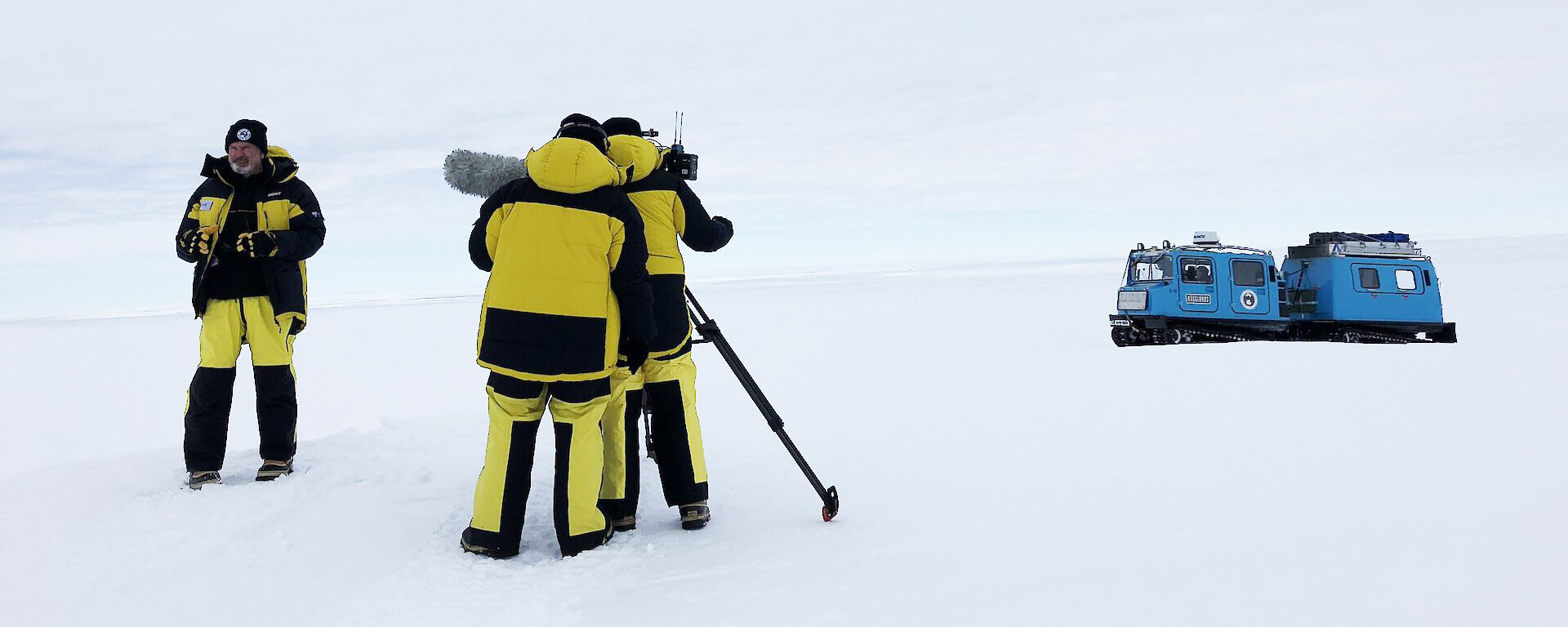Antarctic video gallery
Antarctic Division krill aquarium
Video transcript
Antarctic Division biologist Rob King:
Krill are crustaceans. The Antarctic krill is special, because it’s both large at about five centimetres in size, but also tremendously abundant. We think there’s between 160 and 500 million tonnes of krill swimming around the southern ocean. Antarctic krill are critically important keystone species in the southern ocean ecosystem. They take the primary production, the phytoplankton, and pass that energy up through them in a single step to the higher order predators; so, seals, penguins, sea birds, and the great baleen whales. With Antarctic krill, we're studying the effects of ocean acidification and climate change. Antarctic krill are in an environment that is warming. That has an effect on sea ice. Sea ice is the nursery habitat for young larval krill, and the ocean is also acidifying. What we know now is, if we do nothing about carbon dioxide emissions, by the end of this century, only half the eggs for Antarctic krill in the southern ocean will hatch that currently hatch today. By the year 2300, we would expect the hatch rate to be at 2 percent of what it is today. Understanding what’s going to happen to krill is paramount to understanding the future of the ecosystem.
[end transcript]
Expedition Medicine Winter Course
Video transcript
PAUL: We've tried to design this course to be a real mix of technical skills and extended medical scenarios.
KATE: We are the search and rescue team and often have to provide that field first aid if someone in the team does become injured or unwell while out in the field.
PAUL: We've got a mix of outdoor professionals and the other half are a mix of doctors and we bring them together in a way that the outdoor professionals can use their technical skills to access difficult spots like crossing rivers or abseiling into caves for example and then they can help the doctors get in and do some more advanced medicine in more remote spots than they would normally be able to.
KATE: Practicing packaging up patients focus on keeping them warm, the safe transport of patients but what I really enjoyed learning about is getting that overall big picture on all of the different aspects that go into both the planning and then the actual events around a wilderness medicine retrieval. It’s not quite the same as the hospital setting or the GP setting where the patient comes to me all nice and ready instead we've actually got to work and and make the patient able to be safely transported, stabilised in the field where you don’t always have your optimal and medical equipment around.
[end transcript]
Feeding Antarctica
Video transcript
We send over 740 different line items of food to our stations. This year, we sent about two and a half tons of apples; about four and a half tons of fresh potatoes; and we sent nearly 35,000 eggs to Antarctica. They've been oiled to seal them up. We try to select products that will — that will keep fairly well; potatoes, carrots, onions, that sort of thing. When we transport, them we also use an ozone generator in the container, which displaces some of the nasty gases that tend to make things go off quicker. We'll also use ethylene absorbers. So, ethylene is a key gas which tends to make things right. So by mopping up the ethylene, we can slow down the ripening process. When it comes to chefs, we're really looking for true all-rounders. Being able to make fresh bread every day, because we can’t take pre-prepared bread; being good at pastry — that’s a large part of what we do; but also understanding the needs of the type of personnel that we have on station, but then also having the ability to step up the standard on those special occasions.
[end transcript]
Superstar of STEM
Video transcript
My journey into marine ecosystem modelling really started with me having a passion for the underwater world as a young thing in Tassie, and enjoying snorkeling and diving. Then, through enjoying maths and science at school and being fortunate to have encouraging teachers. We're seeing increases in the number of women that are coming through from undergraduate degrees and into postgraduate degrees. I think that diversity is really critical in science and in research. I think we're at a point where there are some very complex difficult questions that need to be addressed and that flexibility in thinking and diversity of views and creativity and different approaches is really fundamental and that applies in working across disciplines as well.
[end transcript]
Expansion of ice free areas in Antarctica
Video transcript
Dr Alex Terauds: This paper is about the expansion of ice free areas in terrestrial Antarctica under climate change, because over 95 per cent of life in terrestrial Antarctica live in these areas. And we're not just talking about penguins and seals. We're talking about a whole range of plants and animals, from lichens and fungi and mosses down to little invertebrates, like tardigrades and mites and springtails. So there’s a whole range of life that lives in these ice free areas.
Jasmine Lee: Most people probably picture the Antarctic continent as this massive ice and ice sheets. But what they might not know is that a very tiny fraction of the continent, less than one per cent in fact, is permanently ice free. So we see these small patches of ice free areas springing up around the coast and along the mountain tops. Across the continent, we're expecting up to 17,000km2 of new ice free area, and that’s a 25 per cent increase in total area. But nearly most of this will all be concentrated in the Antarctic Peninsula. What the ice melt means is that the ice free areas start to expand in size, and some of them expand so much that they start to join together. So this increasing expansion coalescence leads to increased connectivity between patches that have been separated for, in some cases, probably hundreds of thousands of years.
Dr Alex Terauds: And that’s got implications for how species interact with each other, whether it be native species interacting with each other or whether it be invasive species coming in and interacting with native species. And we also know that, together with the warming climate, this expansion of ice free area will likely provide more habitat and better habitat for invasive species. There is a strong focus on trying to protect and conserve this important biodiversity in terrestrial Antarctica. And if we understand what’s going to happen under different climate change scenarios, then we can actually incorporate that into our conservation planning.
[end transcript]
Midwinter swim at Davis research station
Video transcript
Bryce: I’m an electrician working for the Australian Antarctic Division and the swim was amazing. There is the briefest of briefest moments when you slight feel warm, and then you work out that you’re actually freezing instead!
Kirsten: Today we’re celebrating midwinters day, or the winter solstice. This is the shortest day and the longest night of the year. At 68° south where we are, we have 37 days without sun at this time. Our last sunset was 3 June and next sunrise is 10 July.
Midwinters day is a day of celebration for us. It will involve a plunge in the ocean, group photos, a sumptuous feast and then a live theater and band performance. The reason for the swim is that it’s a polar tradition and expeditioners all around Antarctica will take part in the swim today. For us this involves cutting 1m deep hole in the sea ice. The water temperature is −1.8° Celsius, and the air temperature is around −27 °Celsius which gives us a wind chill of −36 °Celsius — so it’s going to be invigorating.
Midwinters day to our group of 17 expeditioners is the highlight of our season. We’re halfway through our winter and it marks longer days and the return of sunshine. This time of year I’d describe Antarctica as cold, dark and extraordinary. We still have civil twilight, so lots of polar clouds, clear sky and beautiful stars and ethereal auroras which are quite other worldly. So a fantastic time to be here and a real joy to experience it all.
Happy midwinters day!
[end transcript]
Australia’s new icebreaker — steel cutting
Video transcript
Today we started the plasma cutter for the first time on the construction process for Australia’s new Antarctic research vessel. This is a key milestone because it ends the process of design, which has been going for the last 12 months, but the project itself had its inception in 2008 when we first started talking about this ship and the need to replace the Aurora Australis over the next decade. This is the culmination of 10 years of work from people across the Australian Antarctic Division and the Australian Antarctic Program. We’re putting together a 15,000 tonne steel jigsaw puzzle. The next milestone for us will be keel laying where all of the parts of the keel laying will be put together into the first block. Construction is still on schedule for delivery into Hobart in mid-2020 when the ship will undertake its first season in support of the Australian Antarctic Program.
[end transcript]
Australian students chance to fly to Antarctica
Video transcript
Minister Frydenberg:
It’s great to be here at Hawthorn West Primary to announce the start of a national school competition to name our next icebreaker.
The Government is spending nearly $2billion to have a state of the art vessel which will go to Antarctica.
Now the winners of this naming competition will get an incredible opportunity.
Six students from Years 5 and 6 and two teachers and six students from Years 7 and 8 and two teachers will have the chance of a lifetime.
So, would Hawthorn West Primary like to go Antarctica? YES!
Student 1:
It’s called Gondwana Express and I thought it because Antarctica used to be called Gondwana when all the countries were combined.
Student 2:
In respect to the Aborigines, this is an aboriginal word, which is Yarramundi, which is ‘deep water’ in aboriginal.
Student 3:
We thought of all these together. Another one was the Southern Cross star which we thought represents Australia and the stars.
[end transcript]
Anzac Day at Casey research station
Video transcript
I spent 18 years in the military. I was in the Australian Army as a communications technician, and I was operationally deployed on a number of occasions. The most significant of those were to East Timor and to Iraq.
For me, Anzac Day is a chance to reflect on the sacrifices made by all of those people that served before me, to remember the people that I served with, and to be thankful for the soldiers, sailors and airmen who are still serving today.
This year at Casey, we'll be marking Anzac Day with a gunfire breakfast followed up by a dawn service, and then after that, hopefully a couple of games of two-up. For me, it’s a special occasion to recognise; to come together as a station community, and to take a step back from our everyday lives to appreciate the sacrifices that have gone into making Australia the country that it is today, and providing us with the opportunities that we have such as working here in Antarctica.
[end transcript]


